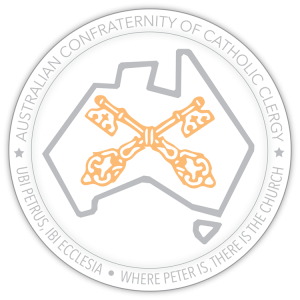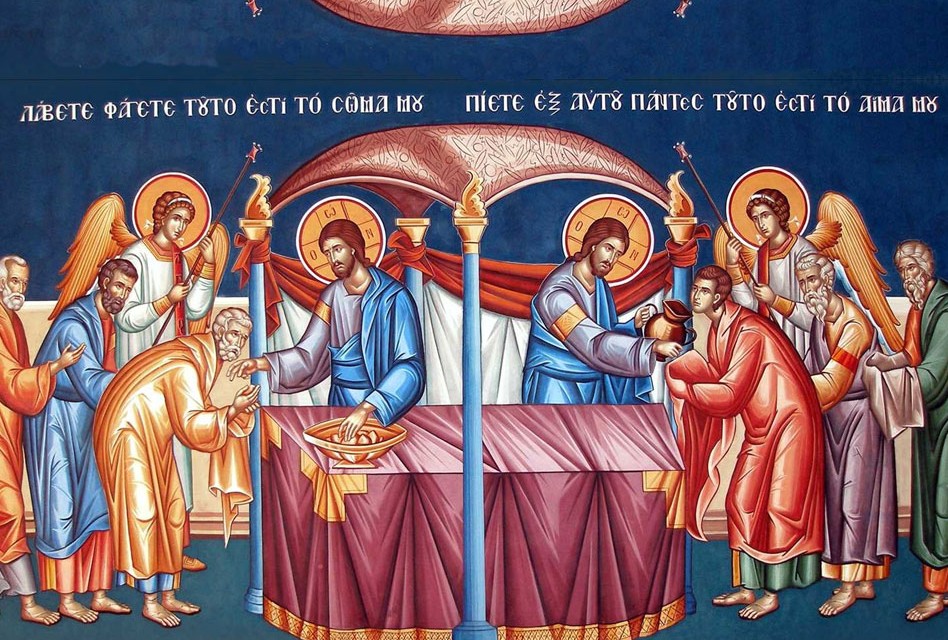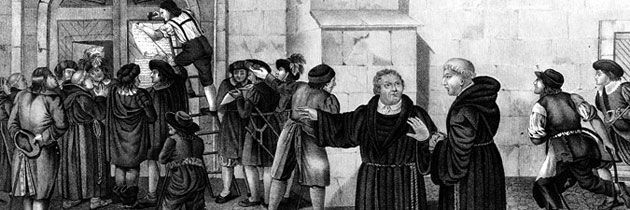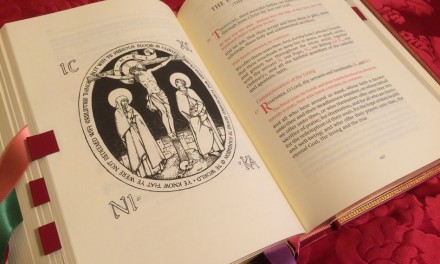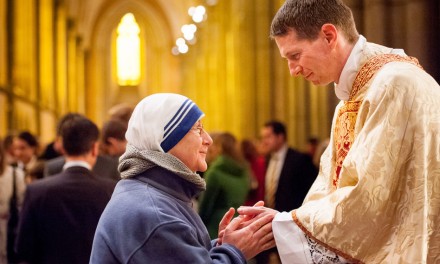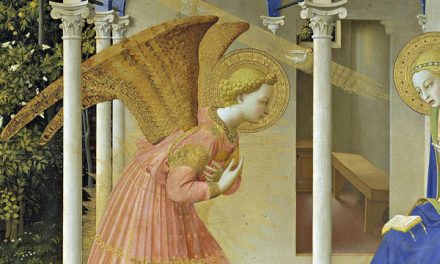Ever since apostolic times the Church has shown deep concern to offer a type of worship which would meet the exigency of God’s utter holiness. Therefore, she always prayed to God the Father, particularly in the Latin tradition, through Christ in the Holy Spirit. Our Lord Jesus Christ instructed us to adore God “in Spiritu et Veritate.” (Jn 4:23)
In fact, it is only in the Holy Spirit can one truly adore Christ – that is, recognise His Divinity, according to the words of Saint Paul: “Nemo potest dicere, Dominus Iesus, nisi in Spiritu Sancto.” (1 Cor 12:3) In the Lord’s Prayer, we pray first of all that God’s name be hallowed: “sanctificetur Nomen Tuum.” This means that when the faithful pray and worship God, they must be conscious that He is the All-Holy God, and must behave accordingly. Jesus Christ Himself, in His “High Priestly Prayer” (Jn 17), began by asking for the glorification of both the Father and the (Jn 17, 1) and He referred to His Father as “Holy Father.” (Jn 17:11)
Print Friendly Format
Download and view this article as it appeared in the Summer 2015 issue of The Priest.
Therefore awareness of God’s deep holiness is the first condition and is typical of Christian worship. And, naturally, it demands typical gestures of adoration, such as bowing, prostrations, and also silence, which expresses an interior attitude of awe and reverence. The most authoritative witness to these fundamental attitudes of Christian worship is the Book of the Apocalypse, which presents to the eyes of Christians the heavenly liturgy as the real model for worship on earth. The reference to the model of heavenly worship (specifically in the allusion to the angels) is the main and constant characteristic of the liturgy throughout two millennia, from the Apostolic Fathers up to the Magisterium of the Second Vatican Council.
Multiple witnesses to this attitude from the most ancient times include St John Chrysostom (4th – 5th century), who is a remarkable witness to the liturgical tradition of Antioch and Constantinople. The liturgy of the Church has to be modeled by the heavenly liturgy of the angels. Therefore the Church on earth, in worshipping and adoring the Divine Majesty especially in the Eucharistic liturgy, has the duty to imitate the angels in their interior disposition (purity of heart) and in her exterior gestures. Witnesses from the Patristic Age demonstrate that indea informed the conscience of the universal Church, from Rome and Carthage to Jerusalem, Antioch and Constantinople. The heavenly liturgy of the angels consequently became an indispensable and constant measure of the authentic liturgical tradition.
St John Chrysostom: Doctor Eucharisticus
The Byzantine Tradition attributes authorship of its liturgy or anaphora to Saint John Chrysostom, also known by the title “doctor eucharisticus.” In his sermons this saint repeatedly stresses the presence of the angels in the earthly liturgy and invites the faithful to worship God in spiritual union with them. St John names the angels “co-servants” (syndouloi — an expression found in Revelation 19:10 and Revelation 22:9) of the faithful, who joyfully celebrate the paschal Eucharistic liturgy.{{1}} [[1]]Cf. Sermo adversus ebrios et de resurrectione, 2: PG 50, 435.[[1]]
In his homilies on Isaiah the doctor eucharisticus describes the spiritual union of the worshipping faithful with the angels in such a way that there would be no difference between the voice of the faithful and the voice of the angels, as if they would sing with one identical voice the hymn of the Sanctus. The source of this union is Christ himself through his sacrifice of the Cross. It is thanks to the Incarnation of the Son of God that the Sanctus, which before was sung only by the angels in heaven, is now also sung by the faithful on earth. Christ Himself brought the angelic hymn down to earth, and therefore the church on earth is able to sing this hymn in her liturgy in union with the angels.
The Second Vatican Council’s Constitution on Sacred Liturgy, Sacrosanctum Concilium, refers the same thought in the following affirmation:
Jesus Christ, the High Priest of the New and everlasting Covenant assuming the human nature brought to this earthly exile the hymn, which is sung for all eternity in the heavenly dwellings. He gathers around Himself the universal human community in order to sing together with her this Divine song of praise.{{2}} [[2]]Vatican II, Sacrosanctum Concilium, no. 83.[[2]]
St John Chrysostom exhorts the faithful, giving us concrete indications on how to spiritually imitate the worshipping angels. I will try to paraphrase his words in this way: ‘Just as the angels sing, we can sing together with them. Just as the angels stand upright, we can stand reverently with them. Just as the angels extend their wings, we can extend the wings of our souls. Just as the angels fly around the throne of God, in our thoughts we can circle around God.
Let us contemplate his words:
Do you recognise this voice? Is this voice our voice or the voice of the seraphim? This voice is at the same time our voice and the voice of the seraphim thanks to Christ who has broken down the dividing wall, who has reconciled heaven and earth, making two become one. Indeed this hymn was sung before only in heaven. But at the moment the Lord has deigned to descend to earth, He brought this song also to us. Therefore the great pontiff standing at this sacred table to offer the spiritual worship [logiken latreian], to offer the bloodless sacrifice, does not invite us only to listen devotedly, but having remembered first the cherubim and then the seraphim, he exhorts all of us to send up to heaven this tremendous song as we belong to their choir [synchoreuónton]. Then he invites us to lift up our thought from the earth and raises up every one with these or similar words: sing together with the seraphim, stand up together with the seraphim, together with them extend the wings of your mind, together with them encircle the throne of the King.{{3}} [[3]]John Chrysostom. Homily on Isaiah, 6, 3.[[3]]
The concrete and fundamental cause of the sacred, transcendent and tremendous character of the liturgy is not an elevated idea or a religious feeling, but the gift of the love of God which is visibly laid down on the altar of the sacrifice. That is: the Eucharistic body of Jesus Christ, filled with the fire of the Holy Spirit. In the same homily on Isaiah, St John Chrysostom invokes the “gift of love” (charis tes philanthropias) and the “fire of the Spirit” (pyr pneumatikon). This visible gift of the love of God which the faithful see and receive during the Eucharistic liturgy demands from the faithful an attitude of awe and of veneration, in accord with the example of the seraphim described by the prophet Isaiah. In itself, the holiness of God is inaccessible and invisible to the human eye. But God admits the angels to adore His immense holiness in heaven. In heaven, in the presence of the unfathomable holiness of God, there is the model and the example (typos) of all holy realities and of all holy gestures, which the Church on earth possesses and practices.
This most holy reality in the Church on earth is the Eucharistic Body and Blood of Christ. After Him then is the altar, upon which His Body and Blood become really and substantially present through the act of the Eucharistic sacrifice. The Eucharistic Body and Blood of Christ are united to the Divine Godhead in the person of the Eternal Son of God. This Divine person is therefore the ultimate source and foundation of the holiness of the eucharistic species.
Christ’s redemptive sacrifice on the cross is the revelation of the immense and unending love of God to men, of His philanthrophia, and this is symbolized in the Bible by fire. Therefore the ultimate model and example (typos) of the altar of the cross and of the altar of the Eucharist is the fire of Divine love blazing in eternity, in heaven. In the sacrifice of the altar and in the Eucharistic gift of the Body of Christ, this eternal, heavenly and Divine fire becomes visible and really present, and even touchable. No angels – even the highest seraphim – dare to touch the Divine fire of the Eucharistic Body of Christ.
The prophet Isaiah explains this behavior using the symbol of the tongs, with which the angel took the burning coal from the altar. (Is 6:6) It is astonishing that weak and sinful men can take the burning coal of the Eucharistic Body of Christ directly into their hands, without tongs. This aspect refers firstly to the priest, because his hands had been consecrated in order to be objectively more suitable to touch and to distribute the most holy sacrament, the sancta sanctorum, the Eucharistic body of Christ. Pope John Paul II elaborates on this in his Apostolic Letter Dominicae cenae:
We should also always remember that to this ministerial power we have been sacramentally consecrated, that we have been chosen from among men “for the good of men.” We especially, the priests of the Latin Church, whose ordination rite added in the curse of the centuries the custom of anointing the priest’s hands, should think about this.{{4}} [[4]]John Paul II, Domenicae cenae. 24 February 1980, no. 11.[[4]]
In his magisterial work on the priesthood (De sacerdotio) St John Chrysostom insists the hands of the priest have to be sacred, because they touch the Body of Christ:
What great purity and what real piety must we demand of him? For consider what manner of hands they ought to be which minister in these things, and of what kind his tongue which utters such words. Ought not the soul which receives so great a spirit to be purer and holier than anything in the world?{{5}} [[5]]John Chrysostom, De Sacerdotio. Book VI, 4.[[5]]
The following extract from the homily on Isaiah illustrates very clearly this aspect of the liturgical and Eucharistic theology of St John Chrysostom:
Which wonder is the fact, that although you are standing in the liturgy together with the seraphim, God permitted you to touch those things which the seraphim don’t dare to touch. The prophet says: ‘Then flew one of the seraphim to me, having in his hand a burning coal which he had taken with tongs from the altar.’ That altar is the prefiguration (typos) and the image (eikon) of this, our altar, in the same way as that fire is the prefiguration (typos) and the image (eikon) of this spiritual fire. The seraphim didn’t dare to touch the coal with his hands, but took it with the tongs, whereas you take it with your hand. When you consider the dignity of the gift which is laid down on the altar, this is greater than the contact with the seraphim. And when you reflect about the love which God has towards men (philanthrophia), then you will recognise that He has not despised our weakness when he laid down on the altar the gift of His love.”{{6}} [[6]]John Chrysostom. Homily on Isaiah, 6, 3.[[6]]
The importance of liturgical ‘externals’
The more the faithful recognize that the Eucharistic Body of Christ is the greatest sign of the sanctity and of the love of God, the more they can respond to this gift in an interior attitude of gratitude, of humility and of love. From this interior act illuminated by faith flows naturally an exterior behavior which expresses adoration and lovingly reverence. Therefore the exterior gestures of adoration and reverence in the liturgy cannot be considered secondary.
The very suggestive examples of the behaviour of the worshipping angels as described in the Bible (especially in the book of the prophet Isaiah and in the book of the Apocalypse) remain a point of reference for how the Church on earth has to worship when she desires to worship God in the Truth (in Christ) and in the Spirit. According to the teaching of the Fathers of the Church these angelic examples are given in order to be imitated by the faithful. And these examples are very concrete and accessible to men.
The first thing is this: to be interiorly orientated toward God and His glory, toward His Face. His Face is ultimately seen in Jesus Christ on the Cross and in the sacrament of the Eucharist.
Then follows this: to recognize God’s majesty, God’s holiness and His love. Then comes this important condition: to ask the merciful God for the grace of interior purity. From this flows the exterior act, the means to make oneself also exteriorly small: to bow, to genuflect, to prostrate.
Then follow other typical exterior acts of lovingly reverence and of awe such as: pronouncing worthy words of praise and adoration like the Sanctus of the angels,; protecting the sacred with a veil, or behind steps and rails (iconostasis, communion rails); kissing holy objects (firstly the altar); keeping silence during the liturgy; touching the most sacred reality (the Eucharistic Body) with consecrated, anointed hands.
The faithful have the unique privilege of seeing and touching the incarnated God in the Eucharistic mystery. Therefore they must show a special reverence towards this unfathomable mystery. And again the faithful find in the angels an example for imitation in their external behavior. In mentioning the reverent attitude of the angels in front of the empty tomb of Christ, St John Chrysostom exhorts the faithful to consider the angelic example, taking into account that in the Eucharistic liturgy there is not the empty tomb of Christ, but the presence of the living Lord himself. Consequently one’s behaviour in the presence of the Eucharistic Body of Christ should be even more reverent than in front of the empty tomb.
In his homily about the cemetery and the Cross he gives this explanation:
I exhort you to approach the immolated Lamb with fear, veneration and awe. You certainly know in which manner the angels stood in front of the empty tomb, even though there wasn’t more the body of the Lord. Nevertheless the angels showed great reverence towards the place which received the body of the Lord. When the angels who by their excellence exceed very much our human nature behave themselves in front of the tomb with so great reverence and awe, how can we approach not the empty tomb, but the sacred table upon which has been laid down the Lamb, with noise and chatter?”{{7}} [[7]]John Chrysostom, Hom. in coemet. et crucem, 3.[[7]]
Even though St John Chrysostom very much stresses the soul’s interior purity as the first important condition for an authentic participation in the liturgy, he nevertheless exhorts the faithful surprisingly often about the exterior gestures of adoration and the reverent exterior behavior. In doing so he adduces the example of the reverent gestures of the angels to be imitated by the faithful when they enter the church and when they participate in the Eucharistic liturgy. St John calls the church building “the place of angels, of archangels, the kingdom of God, heaven itself.”{{8}} [[8]]“Topos angelon, archangelon, basileia tou Theou, autos ho ouranos.” John Chrysostom, Hom. 36, 5 on 1 Cor.[[8]]
He continues to explain and illustrate that the church is already heaven on earth:
The church is heaven. You can imagine it in this way: if someone would introduce you to heaven, certainly you would not dare to speak to anyone, even when you would see there your father or your brother. In the same way here in the church one should speak only about spiritual things, because here is heaven! You should be completely filled with great fear and reverence even before the tremendous moment of the consecration. Be awe-filled and attentive before you see the holy veils extended upon the altar and the choir of the angels preceding the priest. I say you even more: ascend in this moment to heaven!”{{9}} [[9]]John Chrysostom, Hom. 36, 5 on 1 Cor.[[9]]
The ancient norm of the Fathers
This short overview of the liturgical teaching of St John Chrysostom unequivocally manifests the truth that the first and fundamental characteristic of Christian worship is the awe-filled adoration of the majesty of the triune God in the Eucharistic liturgy. This awe-filled adoration finds her concretisation in the adoration of the Eucharistic Body of Christ in the moment of His offering as the immolated Lamb upon the altar, and again in the moment of receiving Him in holy Communion.
The revealed Word of God itself in the Holy Scripture presents us this characteristic as the indispensable norm of true worship, as it is particularly evident in the Book of Isaiah and the Book of Apocalypse. The Church of the Apostles and of the Fathers faithfully and clearly implemented this first and basic characteristic of the liturgy. This is the vertical, transcendent, Theocentric and Christocentric dimension, which is expressed through the acts of adoration; the proskynesis with all its variety of exterior manifestation. The creatures who as first creatures and in a most perfect and exemplar manner realise such a worship are God’s holy angels.
When the Word of God and the Church Fathers stress the sacred and transcendent dimension of divine worship, they preferentially invoke the angels as examples to be imitated. The letter to the Hebrew describes angels as “liturgical spirits” (pneumata leiturgika, Heb 1:14). They are the first adorers of Christ, the Incarnate Son of God:
When he brings the first-born into the world, he says, “Let all God’s angels worship [prokynesátoson] him.” (Heb 1:6)
The angels lead the Christians to adore God alone, because they categorically reject a worship centred and oriented upon creatures. This mind one can recognize in the following scene from the Book of Apocalypse:
Then I fell down at his feet to worship him, but he said to me, “You must not do that! I am a fellow servant with you and your brethren who hold the testimony of Jesus. Worship [proskýneson] God.” (Rev 19:10)
The same event is repeated in chapter 22, verse 9. From that fact one can recognize the great importance of this liturgical law. When one celebrates the liturgy, one must not put creatures in the centre; neither angels, nor human beings, nor even the human celebrant of the liturgy, but only God, the Incarnate God, the Eucharistic Christ. The magisterium of the Second Vatican Council on liturgy remembers precisely this perennial law of the Christian worship insomuch as the liturgy has to reflect the very nature of the Church:
in [the Church] the human is directed and subordinated to the divine, the visible likewise to the invisible, action to contemplation, and this present world to that city yet to come, which we seek. (Cf Heb 13:14){{10}} [[10]]Vatican II, Sacrosanctum Concilium, no. 2.[[10]]
This first and most important principle of the liturgy, of the lex orandi, which is rooted in the Word of God, was not only faithfully transmitted by the teachings of the Fathers of the Church, but was concretely realized by the manner in which the liturgy was celebrated in their times. Every time the Church tries to reform the liturgy, sometimes renewing and improving it when there are practices alien or contrary to the very nature of the Divine worship, she applied as a criterion the “ancient norm of the holy Fathers” (pristina sanctorum Patrum norma).
The reform of the liturgy, or better said the renewal of the liturgy, as desired by the Council of Trent and Second Vatican Council, followed this criterion. St Pius V, publishing the Missale Romanum in 1570 referred in his bull Quo primum to the “ancient norm of the holy Fathers.” The same phrase was used by the Second Vatican Council in establishing the norms of the reform of the Roman Missal (cf. Sacrosanctum Concilium, no. 50) and the criterion is repeated in the General Institution to the Roman Missal (no. 7). The ancient norm of the Holy Fathers is precisely the norm which stresses the sacred, the Divine, the heavenly and eternal, by acts of adoration and their exterior expressions.
All practical norms in the liturgy and even more those which should be revised or changed must have this aim: to express more clearly the sacred, as demanded by the Second Vatican Council:
“In the renewal of the liturgy the texts and rites have to be ordered in such a manner, that they express more clearly the sacred.”{{11}} [[11]]“Textus et ritus ita ordinari oportet, ut sancta, quae significant, clarius exprimant.” Vatican II, Sacrosanctum Concilium, no. 21.[[11]]
The same phrase was cited by Pope Paul VI in the Apostolic Constitution Missale Romanum (1969) with which he approved the new Roman Missal. The return to the Fathers without doubt should not have as an effect the impoverishment of the sacred, of the transcendent and of the acts of adoration in the liturgy, but precisely the contrary: the return to more acts and gestures of adoration and holy awe. To impoverish the liturgy by reducing the signs of adoration and diminishing the sacred, justifying such a reform as a return to the norm of the Fathers is not only an evident contradiction to the patristic witnesses, but represents also an attitude which the universal Magisterium of the Church condemned as “liturgical archeologism” in the encyclical Mediator Dei of Pope Pius XII.
Two decades before the last liturgical reform in 1969, Louis Bouyer rightly observed:
In order not to confuse our perception of its permanent value with any attempt to mimic and copy childishly what they had and what they did that was peculiar to their time alone, it is probably safer not to consider the Fathers in isolation. What we should do rather is to take an all-inclusive view of the development of the People of God, from the first beginnings of this development to its final achievement in those lasting institutions and living ideas which constitute the Fathers’ legacy to us as to all ages.{{12}} [[12]]Louis Bouyer, Life and Liturgy. 1950, p. 21.[[12]]
Conclusion
It would be meaningful to conclude this short overview of the patristic witness on the sacredness of the liturgy with an actualization of their teaching and examples. I here present some concrete suggestions for an authentic renewal of the liturgy according to the teaching of the Magisterium of the Church, especially the Council of Trent and the Second Vatican Council, the more so because both Councils substantially concord in their teaching about the nature of the sacred liturgy.
A liturgical renewal which would stress more the Christocentric and transcendent character of the liturgy and the acts of adoration as shown also by the examples of the angelic worship, would certainly come closer to the spirit of the Bible and of the Fathers, closer to the “ancient norm of the holy Fathers.”
Concretely this could be realized by practical norms like the following which are besides, already proven by centuries-old experience:
Suggestions for an authentic renewal of the Sacred Liturgy according to the norms of the Fathers
- The tabernacle where Jesus Christ, the Incarnate God, is really present under the species of bread, should be placed in the centre of the sanctuary. In no other sign on this earth is God, the Emmanuel, so really present and so near to men as in the tabernacle. The tabernacle as the sign indicating and containing the real presence of Christ should be therefore closer to the altar and constitute with the altar one central sign pointing to the Eucharistic mystery. The sacrament (tabernacle) and the sacrifice (altar) should therefore not be opposed and separated too much. They should occupy the central place of the sanctuary, spontaneously and naturally attracting focus and attention.
- During the Eucharistic liturgy, or at least during the Eucharistic Prayer, when Christ the Lamb of God is immolated, the face of the priest should not be seen by the faithful. (The seraphim cover their face when adoring God.) Instead the priest’s face should be turned toward God in the sign of the icon of the Crucified Lord.
- There should be more signs of adoration by means of genuflections, especially every time the priest touches the consecrated host, the Lamb of God.
- When the faithful approach the Lamb of God in Holy Communion, they should greet and receive Him with an act of adoration, kneeling down. Such a gesture resembles a little biblical and angelical proskynesis. For what moment is more sacred than this moment of personal encounter with the Lord?
- There should be more room for silence during the liturgy, especially during those moments which most express the mystery of the redemption, like the moment the sacrifice of the Cross is made present during the Eucharistic prayer.
- There should be more exterior signs which express the priest’s dependence on Christ the High Priest. This would more clearly show that the words of greeting (Dominus vobiscum) and the blessing of the celebrant depend upon and flow out from Christ the High Priest. Such signs could be (as was practiced for centuries) the kissing of the altar (which symbolises Christ) or a bowing toward the altar or toward the Crucifix immediately prior to each occasion of the priest’s greeting (Dominus vobiscum) and each time he blesses the faithful.
- There should be more signs which express the unfathomable mystery of the redemption. This could be achieved for example through the veiling of the liturgical objects, because the veiling is an act of the liturgy of the angels (cf Is 6): veiling the chalice; veiling the paten with the humeral by the subdeacon; the use of the burse which hides the corporal (which is a sign of the linen shroud which covered the Body of Christ); veiling the hands of the bishop when he celebrates solemnly; the use of Communion rails as a mean of veiling the altar. Similar signs are the signs of the Cross made by the priest during the Eucharistic prayer and by the faithful at other moments of the liturgy (for example at the end of the Gloria and the Credo).
- There should be a constant sign which expresses mystery also by means of human language. That is to say, by the use of the sacred language of Latin as demanded by Vatican II (Sacrosanctum Concilium, 36 §1). In the celebration of every holy Mass and in each place there could be said a part of the Eucharistic prayer always in Latin.
- Those who exercise an active role during the liturgy, such as reading the Word of God (the lectors) and pronouncing the Prayer of the Faithful, should be dressed in the liturgical vestment (amice, alb and cincture, or soutane and surplice). They should remain during the liturgy in the sanctuary in order to stress the sacred and non-earthly character of their concrete liturgical action.
- The music and songs used during the liturgy should reflect more truly the liturgy’s sacred character. They should come closer to the song of the angels, which demands a common chanting of the Sanctus in every holy Mass. In order to be sing in one voice with the angels not only the Sanctus but the entire liturgy Holy Mass, it is necessary that the hearts, the minds and the voices of the priest and the faithful are directed towards the Lord.
